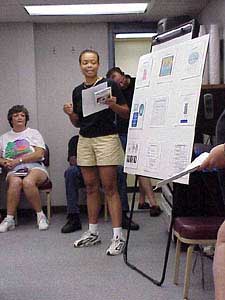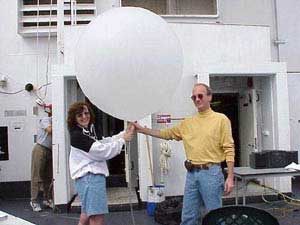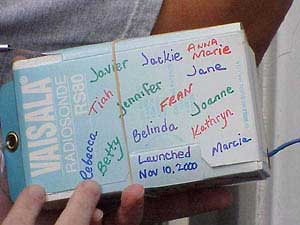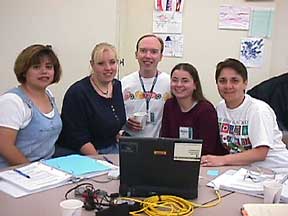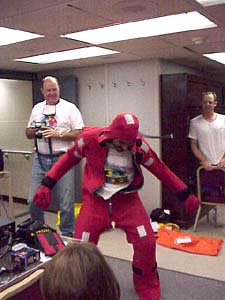 |
|||||||||
skip to content |
|||||||||
COASTing to the Next Level
in Oceanographic Education
by Sharon H. Walker, Mary Alyce Lach, R. Dan Brook, and Tim H. Reid*
|
|
The "Consortium for Oceanographic Activities for Students and Teachers," or COAST, is a working collaborative designed to effectively deliver oceanographic and coastal processes education to pre- and in-service teachers from kindergarten through the twelfth grade (K-12). Each of the COAST members offers expertise in different areas and through focused efforts at specific educational levels provides depth of knowledge and resources in these areas. As a collaborative, the partners provide the broadest spectrum of means, methods and materials for ocean science education, as well as a nationwide telecommunications infrastructure.
The COAST partners include: Operation Pathfinder, a nationally recognized in-service program for K-12 school teachers of predominantly minority students and the development of curricular materials; the Ocean Voyagers program, a teacher pre-service/in-service training system featuring integrated curriculum development, World Wide Web page construction and maintenance, and teachers-to-sea experiences; and STARBORD, a K-12 effort combining training with teacher-student research partnerships to leverage computational science tools for ocean science research. Each of these programs individually creates bridges between ongoing Naval research and formal and informal learning environments through focused teacher education.
Together, the COAST collaboration fuses the strengths of each partner to provide ocean science activities for educators ranging from hands-on experience aboard research vessels, through Web-based instruction, curriculum resources, and video teleconferencing. Operation Pathfinder provides hands-on experiences in marine research and empowers teachers to make these experiences relevant and exciting for their students. Ocean Voyagers works to place marine and ocean studies into a broad curricular context, using, for example, literature, music, the arts, history, geography, or economics to provide students with personally meaningful points of access to oceanographic studies. STARBORD transforms hard data and raw numbers into visual representations of complex problems and conditions in ways that make those data engaging, understandable and useful in local contexts. Each of these approaches makes oceanography and coastal science both pertinent and real in the lives of all learners.
The three COAST components' respective institutions and locations are:
- OPERATION PATHFINDER, facilitated through The University of Southern Mississippi's Institute of Marine Sciences/J.L. Scott Marine Education Center and Aquarium, located in Biloxi, Mississippi, to include ten regional Sea Grant College Programs
- OCEAN VOYAGERS, based at St. Norbert College in DePere, Wisconsin
- STARBORD, represented by Mississippi State University located in Starkville, Mississippi.
Other essential partners in this collaborative effort include
- the Naval Meteorology and Oceanography Command, the Naval Oceanographic Office, the Naval Research Laboratory, and the Office of the Oceanographer of the Navy
- the National Marine Educators Association
- the National Sea Grant College Program and the State Sea Grant College Programs in select affiliated universities in Mississippi-Alabama, Maine-New Hampshire, Delaware, Washington, Oregon, Wisconsin, Minnesota, New York, Hawaii, and North Carolina
- Sea Grant and University researchers
- K-12 pre- and in-service teachers from all Great Lakes (except Pennsylvania) and coastal states in this country and numerous U.S. territories
- Selected museums and aquariums within the U.S.A.
All three COAST components' pre- and in-service teachers are required to implement a staff development program in his/her school or school district (this is a commitment required in the selection process). The 365 precollege teachers who participate in COAST will directly train between 7,200 and 9,000 "fellow" teachers.
|
|
|
COAST Benefits and Impacts for 1998 - 2000:
- 365 pre-college teacher participants;
- 7,320 "second tier" teachers have been positively affected through the staff development programs implemented by the Regional Institute and Sea Scholar participants. These 7,320 teachers have the potential-over a five-year teaching career-of impacting 3,985,740 pre-college students;
- Oceanography and Coastal Processes Resource Guide developed by teachers for teachers in hard copy, CD-ROM, and on the COAST Website http://www.coast-nopp.org/toc.html. The Guide has been aligned with the National Science Education Standards;
- During 2000 the Resource Guide website received 106,000 page requests per month;
- "Win-win" partnership involving 41 sponsors from academia, state and federal government, businesses and industry, and the private sector;
- COAST Website URLs include Pathfinder at http://www.aquarium.usm.edu/coast01.htm, Sea Scholars at http://voyager.snc.edu and STARBORD at http://www.coast-nopp.org/coast_partners/starbord/index.html; and
- Evaluation and assessment revealing significant differences in pre- and posttest cognitive achievement scores by all participants in all regions and Likert-scale attitudinal achievement revealing that all participants perceived content, presenters, activities, and field-trips between 79% to 97% Very Valuable and/or Valuable and between 3% to 21% Average and/or Limited Value.
STARBORD
STARBORD is an acronym for Stimulating Teachers About Resources for Broad Oceanographic Research and Discovery. The program is a high-school-level effort combining training with teacher/student research partnerships that uses computational science tools for ocean science research. It transforms complex problems, hard data and raw numbers into visual representations in ways that make them engaging, understandable, and useful in local contexts.
STARBORD, implemented by Mississippi State University (MSU), combines the strengths of existing partnerships for oceanographic research, precollege and informal science education, and scientific visualization to bring unique capabilities to the COAST collaboration. The university's National Science Foundation Engineering Research Center has been applying state of the art computational science and visualization tools to ocean science problems in partnership with the Naval Oceanographic Office for the last five years.
STARBORD is developing a set of three-dimensional tools for Web-based Oceanographic science targeted at secondary school students and teachers. These tools, developed as a set of integrated and inter-related components, will allow secondary teachers to interact with such oceanographic information as thermography, ocean floor terrain, and salinity to perform investigation and analysis. Students and teachers will be able to interact with the STARBORD resources in three ways. First, they will be able to view the resources, explore linked sites, and apply the tools to data available over the internet from such agencies as the National Oceanic and Atmospheric Administration (NOAA). Second, they will be able to develop or utilize local or regional data, creating models of regional bathymetry, visualizations of local marine life, or analyses of regional phenomena. And third, they will be able to develop new pieces of the STARBORD resources by creating tools, models, analyses and visualizations which become part of the STARBORD environment available nationwide.
Operation Pathfinder
|
|
Operation Pathfinder is a nationally recognized in-service program for elementary and middle school teachers of predominantly minority students. Part of the program involves the development of curricular materials. It provides hands-on experiences in marine research and enables teachers to make these experiences relevant and exciting for their students.
In 1993 Operation Pathfinder was sponsored by the Office of the Oceanographer of the Navy, in cooperation with the University of Southern Mississippi's Institute of Marine Sciences Gulf Coast Research Laboratory/ J.L. Scott Marine Education Center and Aquarium and the Mississippi Alabama Sea-Grant Consortium. From 1994 through the summer of 1997, the partnership expanded to include the National Oceanic and Atmospheric Administration's (NOAA) Office of Oceanic and Atmospheric Research, specifically the National Sea Grant Program, and National Environmental Satellite, Data, and Information Service (NESDIS), and the National Ocean Sciences' (NOS) Office of Ocean and Coastal Resource Management; the U.S. Navy, represented by the Office of the Oceanographer of the Navy, the Naval Meteorology and Oceanography Command (NMOC), and the Naval Research Laboratory (NRL); the U.S. Department of the Interior's Office of Territorial and International Affairs; host, Institutions of Higher Learning (universities and colleges) within the Sea Grant network; and the National Marine Educators Association (NMEA).
For over two decades, Sea Grant and its member institutions of higher learning have been involved in teacher pre- and in-service programs, curriculum development, and informal education for precollege students and the general public. This partnership has provided equipment, ship time, resources, materials, new technologies for teleconferencing and satellite communications, and speakers for the six geographic regions. For five years, Operation Pathfinder has been instrumental in "bridging the gap" between researchers and precollege teachers, students, and, to some degree, the general public. Operation Pathfinder workshops have shown that what researchers "do" in their respective laboratories has relevance in the classroom. From 1993-1997 approximately 500 minority teachers or teachers of minority students were involved in Operation Pathfinder institutes. Over a five-year period, these teachers have impacted or have the potential to impact approximately 5,000,000 students and approximately 8,000 fellow teachers through staff development programs.
To find out more about Operation Pathfinder, visit their home site at: http://www.aquarium.usm.edu/
Ocean Voyagers
|
|
Ocean Voyagers is an educational outreach initiative consisting of an interdisciplinary curriculum program. It is designed to allow precollege teachers and their students to gain real-world knowledge about oceanographic science, social science, maritime cultures, communication, literature, and the language arts. The Ocean Voyagers program is organized around the notion that real-life oceanographic ship operations, problems and destinations present appropriate classroom topics that integrate all principal subjects. The program connects the Navy's oceanographic fleet with classrooms around the country via emerging technology, including the Internet and satellite communications. The program is a structured planned unit with a wide range of resources that teachers may select based on the needs and interests of their students. Topics will include: sea and seafaring, nautical skills, oceanography, geography, meteorology, marine biology, geology, communications, literature, the arts, and interdisciplinary studies of distant lands and peoples. Ocean Voyagers encourages teachers to incorporate their own lesson ideas, teaching styles and instructional techniques, as appropriate for their students.
The Ocean Voyagers program was designed by professors from St. Norbert College and staff from the Oceanographer of the Navy's Office and the Naval Oceanographic Office. The Ocean Voyagers program is designed to facilitate broad-based oceanographic education through a variety of resources including an internet web site, direct contact with the Navy's fleet of survey ships, teacher workshops, teachers-to-sea programs, and integrated curriculum development, coordination, and dissemination. The recently completed $9 million Bemis International Center, a state-of-the-art teaching and conference facility, will assist in the implementation of the Ocean Voyagers program through its three computer laboratories, six interactive multimedia classrooms, and a similarly-equipped fully-interactive auditorium.
To find out more about Ocean Voyagers, visit their home site at: http://voyager.snc.edu.
|
*Authors' affiliations: Sharon Walker-The University of Southern Mississippi and the MS-AL Sea Grant Consortium; Mary Alyce Lach-St. Norbert College; R. Dan Brook-Mississippi State University; and Tim H. Reid-the MS-AL Sea Grant Consortium. The Mississippi-Alabama Sea Grant Consortium (MASGC) is an organization of eight universities and laboratories dedicated to activities that foster the conservation and sustainable development of coastal and marine resources in the states of Mississippi and Alabama. MASGC was established as the first bi-state Sea Grant program in the nation on June 29, 1972. |
[1/16/01]
CLIMATE · OCEANS, GREAT LAKES, and COASTS · WEATHER
and AIR QUALITY
ABOUT US · RESEARCH
PROGRAMS · EDUCATION · HOME
